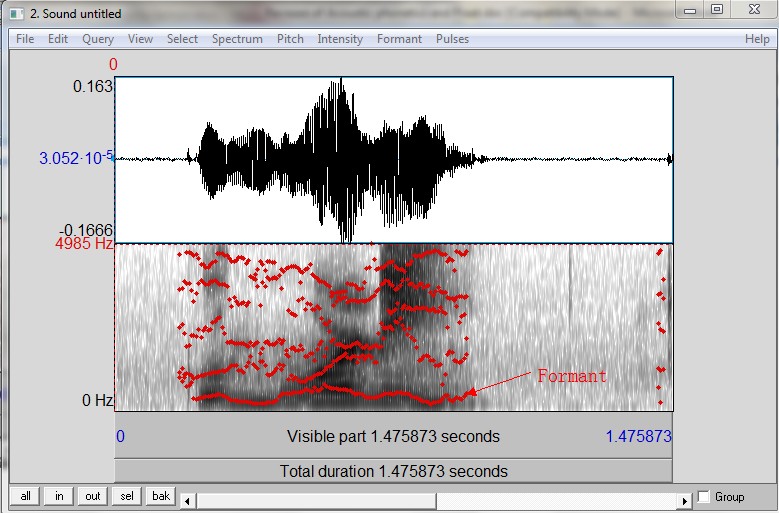

Now that you have completed the pre-recording sound check and the sound level calibration, you are ready to obtain the voice sample recording. You are now ready to begin the acoustic voice analysis. For example, if the sound-level meter measured 70 dB but Praat measured 61 dB, then you should add 9 dB (i.e., 70 dB – 61 dB) to all the dB outcomes.Įxit out of the pre-recording sound check. Add this difference to all the dB outcomes measured with Praat. ‘Stop’ the recording > ‘Save to list & Close’ > ‘View & Edit’ the sound file > then measure the dB of the habitual /a/.ĭetermine the difference in dB between the sound-level meter and Praat. Record the average dB measured on the decibel reader. If you do not have a Class 1 or Class 2 sound level meter, you can use the NIOSH Sound Level Meter app on your mobile phone. Set up a sound-level meter ~30 cm from the front of the speaker’s mouth. This should ideally be 4-10 cm from the mouth, but will likely be further if you are using a computer's built-in microphone (e.g., during a class assignment) rather than using a head mounted and handheld microphone (e.g., clinical practice). Make note of the mic-to-mouth distance for future evaluations. Repeat until the loud voicing is in the yellow zone (but not red zone) and verify the soft voice is still being detected. If it goes into the red zone, adjust the gain level (if using a pre-amp) and/or move the microphone further away. The loud voicing should not go in the red zone. Sustain an /a/ that is ~2x the loudness of normal speaking. If it is not detected, then adjust the gain level (if using a pre-amp) and/or move the microphone closer or move to a quieter environment. The soft voicing should be detected on the Meter in the SoundRecorder window. Sustain /a/ as soft as possible without it being a whisper. In the Praat Objects window, click ‘New’ > ‘Record mono Sound…’ > ‘Record’

Pre-Recording Sound Check of Soft and Loud Vocalizations Note: ASHA-recommended guidelines is to use an omnidirectonal microphone. If it is unidirectional, then ensure it is directly in front of the mouth. If the microphone being used is omnidirectional, then ensure sure to position the microphone at a 45º angle from the center of the mouth. Step-by-step instructions are outlined below, with a 6-minute video tutorial available for viewing below the written instructions.Įnsure the microphone is 4-10 centimeters from the sound source (i.e., the person vocalizing). Therefore, complete the below prompts immediately before beginning a voice sample recording with an examinee. Part 2: Pre-Recording Sound Check and Sound Level CalibrationĪ pre-recording sound check and sound level calibration is required immediately before each and every acoustic analysis assessment. In the same sound window, g o to ‘Intensity’ > ‘Intensity settings…’ and in the section ‘View range (dB):’ enter the numbers 50 and 100 for the minimum and maximum intensities. In the same sound window, go to ‘Pitch’ and ‘Pitch settings…’ and in the section ‘Pitch range (Hz):’ enter the numbers 60 and 600 as the minimum and maximum F 0. In the ‘Show Analyses’ window, ensure ‘Show spectrogram’, ‘Show pitch’, ‘Show intensity’, and ‘Show Pulses’ are selected and change the 'longest analysis (s):' from 10 to 200 or 300. In the sound window, click ‘View’ and ‘Show analyses…’. Open (or create) an audio file the Praat Objects window by selecting ‘View & Edit’ If you are new to Praat, I recommend viewing the extended video tutorial, otherwise the abbreviated video covers the below information. Step-by-step instructions are outlined below, with an extended (15-minute) and an abbreviated (1-minute) video tutorial available for viewing. Part 1: Preparing Praat's Default Settings
#Praat voice install
Therefore, you should download and install the freeware program Praat (free!) prior to beginning this tutorial. This tutorial will use Praat for the acoustic analysis software. I have no financial conflict of interests for any of these pieces of equipment. The equipment I will be using in this tutorial which you could consider using for your own acoustic analyses are: head-mounted, AKG, omnidirectional, condenser microphone ($165 USD) a pre-amp (~$120 USD) a connecting cable for the microphone and pre-amp ($75 USD) and a personal laptop compter. This article also outlines a description of the minimum requirements for assessment equipment, testing environment, and acoustic outcomes. Many of the analysis settings and protocols used in this tutorial were pulled from the ASHA-recommended guidelines in that article. To begin, you should read the free, open-access article by ASHA. This tutorial will take you through the steps necessary to complete an acoustic assessment of voice - an integral component of the comprehensive, gold standard voice assessment.


 0 kommentar(er)
0 kommentar(er)
